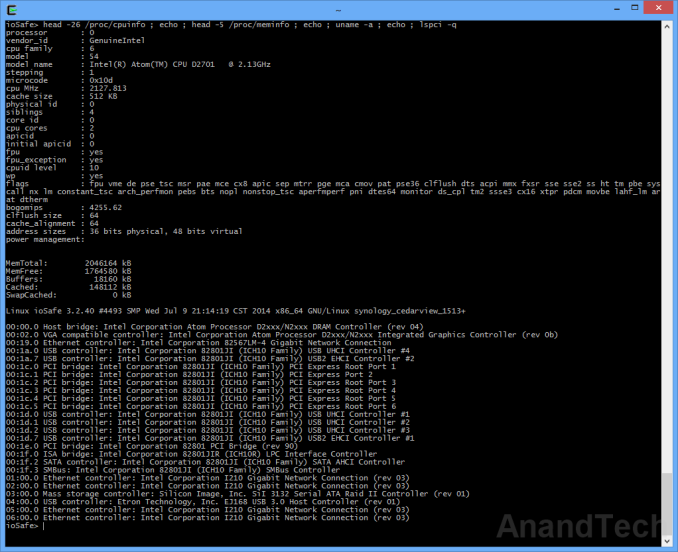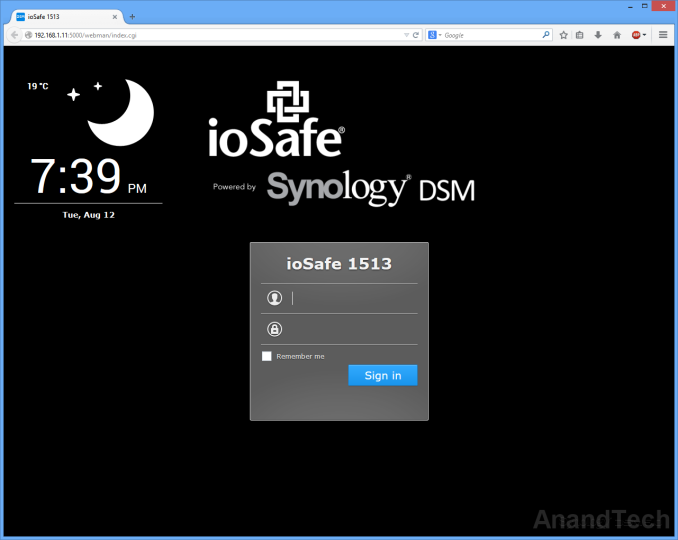ioSafe 1513+ Review: A Disaster-Resistant Synology DS1513+
by Ganesh T S on August 13, 2014 7:30 AM EST- Posted in
- NAS
- Storage
- Synology
- Enterprise
- ioSafe
Chassis Design and Hardware Platform
The Synology DS1513+ has been around for more than a year now. ioSafe announced the disaster-resistant version back at CES and tentatively set the shipment date for March. However, it wasn't until late July that the design was finally perfected. Compared to the SoloPRO and the ioSafe 214 platforms, the 1513+ is quite different when it comes to power consumption and thermal requirements. Tackling the heat dissipation was one of the main challenges faced by ioSafe in the product development process.
ioSafe uses three main patented technologies in disaster-proofing the 1513+:
- HydroSafe: Waterproofing by placement of drives in a metal cage sealed with rubber gaskets.
- DataCast: Fireproofing by surrounding the drive cage with a super-saturated gypsum structure
- FloSafe: Vents in the gypsum structure to allow for cooling during normal operation.
ioSafe has a technology brief explaining how these are applied in the 1513+. It is reproduced below:
In traditional NAS units / storage arrays, the arrangement of the fans has to ensure that air flows across the surface of the drives in order to cool it down. This is not directly possible in the ioSafe NAS designs because the hard drives are inside a waterproof sealed chamber. Ambient air is not designed to enter the waterproof chamber, but, through the fireproof door and to the outside of the extrusion. For cooling purposes, the design relies on a combination of conduction (from the drives to the extrusion) and convection (from the extrusion to the ambient air flowing over the extrusion). Note that the waterproof front door of the drive cage as well as the fireproof front face are essential parts of the cooling mechanism. Without these, the airflow across the serrated drive cage might not be enough to draw away the heat through the fans.
On the software front, the ioSafe 1513+'s Synology DSM is based on a Linux kernel (v 3.2.40). The interesting aspects of the hardware platform can be gleaned after accessing the unit over SSH.
Note that the unit has four Intel I210 GbE NICs connected via PCIe. The USB 3.0 ports are from an Etron EJ168 PCIe x1 to 2x USB 3.0 bridge,while a SiI 3132 PCIe x1 to 2x eSATA host controller with port multiplier support enable the two eSATA ports (to which the expansion chassis units get attached). Since the system utilizes the ICH10 I/O controller hub (this is the standard Cedarview storage platform that Intel promoted a few generations back), all the SATA ports for the drive bays come off the hub without the need for any bridge chips.
Our review unit came with the drives pre-initialized in a SHR volume (1-disk fault tolerance). ioSafe has a special wallpaper for the web UI, but, other than that there is no customization - all DSM features that one might get after initializing the unit from a diskless configuration are available in the pre-installed version also.
We have covered DSM 5.0's setup and usage impressions in our recent DS214play and DS414j reviews. There is not much point in rehashing the same excellent setup and usage experience. That said, each of those reviews concentrated on a particular DSM aspect, and this review will be no different. After the sections presenting the performance numbers, we will take a detailed look at the iSCSI features of DSM 5.0.













43 Comments
View All Comments
ganeshts - Wednesday, August 13, 2014 - link
I hope we don't have readers chiming in about how they can build a better DIY NAS than the one presented here :)hodakaracer96 - Wednesday, August 13, 2014 - link
I for one, was hoping for fire and water testing :)Samus - Wednesday, August 13, 2014 - link
Some good "tests" on youtube:https://www.youtube.com/watch?v=qm4J_1jFxik
https://www.youtube.com/watch?v=yszTblXpwgY
ddriver - Thursday, August 14, 2014 - link
I wouldn't bet money on this product surviving an actual fire. Insulation seems too thinganeshts - Friday, August 15, 2014 - link
I hope you are kidding :) ioSafe's products have been proven to work - they have many real world success stories. Quite sure they can't have big-name customers if they don't prove that they can really protect the drives as per the disaster specifications quoted. Just for reference, a picture of one of the 1513+ units subject to both fire and water damage is in our CES coverage: http://www.anandtech.com/show/7684/synology-dsm-50...ddriver - Friday, August 15, 2014 - link
Well, looking at the youtube videos of fire test I am not really impressed. Surely, it will probably survive a mild and short fire with not much material to burn, but being in a serious blaze and buried in blowing embers it will not last long. A regular NAS unit put in a small concrete cellar with no flammable materials in it has better chances of surviving.And this probably has to do with how they test their products, which I can logically assume is safe controlled fires carefully estimated to not exceed the theoretical damage the unit can handle. But how many houses did they torch to test their products in real life disaster situations? My guess is zero :)
ddriver - Friday, August 15, 2014 - link
I mean, it will most likely survive a plastic trash can full of paper catching fire and burning out next to it, but will it survive an actual blaze disaster? I highly doubt it.In other words, I don't doubt the product will survive what they claim it can survive, I doubt that the disaster specifications they quote reflect real world fire disasters well enough. They will probably suffice for "fire accidents" but not really in "fire disasters".
ganeshts - Friday, August 15, 2014 - link
Does this convince you?http://geardiary.com/2009/08/04/could-your-hard-dr...
As for real-life situations, they are claiming protection for the following fire situation: 1550°F, 30 minutes per ASTM E-119
I remember reading a post about some statistics regarding how fast fire services respond to hourhold fires, and ioSafe's protection circumstances fall within that. Anyways, this product is targeted at SMBs / SMEs who have buildings as per fire marshal codes. Any blaze in such a situation is probably going to be controlled well by building sprinklers.
ddriver - Friday, August 15, 2014 - link
It is the 1550 F number that bothers me. That's below 850 C, and even wood and plastic burns at almost 2000 C using air as oxidizer. Most of the stuff that is flammable burns around 1950 C, so targeting the product at 850 C pretty much excludes direct fire damage. E.g. if you have a wooden cabin and if it burns to the ground, the data is very unlikely to recover.That is why I drew a line between "accident" and "disaster". This product will do in the case of fire accidents, but in the case of a fire disaster its specs are just not enough.
So, it is a "fireproof" product for buildings with anti-fire sprinkler installations and with good accessibility for fire services. In short, it doesn't protect in the case of fire disasters, but in the case of fire accidents and the water used to put them out.
robb.moore - Friday, August 15, 2014 - link
Hi ddriver-The average cellulose building fire temps are between 800-1000F for about 10-15 minutes. We've been in many fires and have a record or zero data loss for fire disasters in the real world. Most of the building damage is actually caused by firefighter hoses - not the actual fire. The absolute temperature (1500, 1700, 2000...) is not as important as the duration actually. Think of a pot of water boiling on the stove - as long as there's water in the pot, the pot doesn't melt because the endothermic action of the boiling water (212F) keeps the pot from melting. The flame temp could be anywhere between 800 and 3000+? and the water would still boil at 212F (assuming sea level pressures). You could use an aluminum pot (which melts at 1100) and still be ok. Once the water runs dry, then you'll ruin the pot. It's actually the same with all fire safes (and ioSafe). There's water chemically bound to the insulation that works to cool the inner chamber and keeps it at survival temps. Our fire test standards is hotter and longer than typical building fires and the systems we sell typically can go double the standard just to be conservative.
The fire protection technology is not new. We use the same proven techniques that have been around for 100 years. What unique about ioSafe is how we combine fire/water protection with active computers – managing the heat produced during normal operation while protecting against extreme heat possible during a disaster.
As Ganesh has said, we test both internally and externally (with the press watching and recording!) in both standard and (ahem) very non-standard ways at times - we've NEVER failed a demo. One of these days, I'm sure a gremlin's gonna pop up and we'll get recorded by the press as failing a disaster demo (because a HDD refuses to boot) but that's the risk we take. Our stuff's legit.
And btw, a cellar is a great place for tornados and fires but not so good for water main breaks or river floods – we’ve seen it all :)
Robb Moore, CEO
ioSafe Inc.